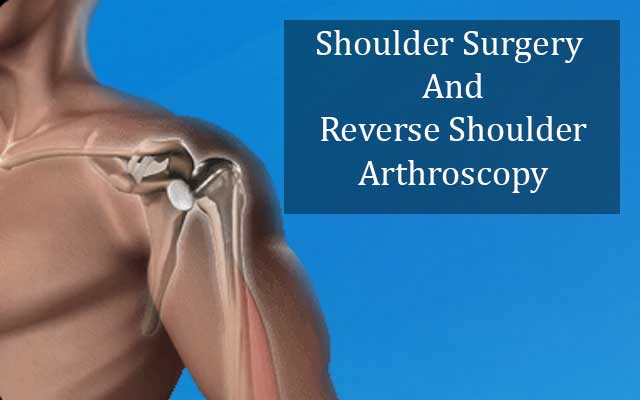
DAVE WATTS, MD
Orthopedic Surgeon
Shoulder Injuries and Reverse Shoulder Arthroscopy
Shoulder pain is a complex problem which can occur due to problems in the related tendons, muscles, and ligaments. The shoulder pain can reduce mobility, and decrease muscular strength. Shoulder injuries affect your daily lives and make it difficult to perform routine tasks.
Let us have a look at some of the most common reasons for shoulder pain.
Fracture
The breaking of bones is called fracture. The shoulder fractures usually occur in collarbone, upper arm bone, or shoulder blade.
An older patient falling on their shoulder can cause a fracture. A high impact injury in adults to their shoulder can cause a serious injury. Some examples include motor vehicle accident or injury during a contact sport. Fractures can result in bruising, swelling, and pain.
Arthritis
Arthritis can also become responsible for shoulder pain. Osteoarthritis is the most common type of shoulder arthritis. Wear and tear can cause seriously shoulder problems. Typical symptoms can include pain, stiffness, and swelling. It takes for the osteoarthritis to develop, causing pain over time.
Some sports activities can also result in shoulder arthritis. Similarly, wear and tear can also add to the arthritis condition. Some of the other types of arthritis impacting shoulder include joints inflammation, infection, or rotator cuff tear.
People who get affected by shoulder arthritis avoid doing routine activities. The shoulder arthritis may also result in stiffening of the surrounding soft muscles.
Instability
The heat of the upper arm bone going out of its place or socket causes instability. Overuse of the shoulder joint or an injury can cause instability. In some cases shoulder instability is partial while in others it is complete.
If the tendons and muscles responsible for stabilizing the shoulder become loose, this can result in repeated instability problems. The orthopedic surgeon in Sioux Falls SD may perform a surgery to help stabilize the shoulder.
Impingement
The pressure put by the shoulder top on the soft tissues can result in impingement. The condition of shoulder impingement is painful and can badly hurt. The impingement of the shoulder can result in tendinitis or bursitis. Sometimes, shoulder impingement can result in rotator cuff tear.
Tendon Tears
The tendons may split or tear because of an injury. There can occur degenerative changes because of advancing age. Sometimes shoulder tendon tears can also occur because of sudden injury or shoulder wear and tear. Sometimes, these tears are partial at other times they are complete.
Complete tendon tears of the shoulder occur in most of the cases. These tears pull away the tendon from the bone. The most common shoulder injuries include rotator cuff tear and biceps tendon tear.
Tendinitis
Tendon’s role is to connect a muscle with a bone. The wearing down of tendons can start impacting the shoulder over time. Tendinitis results in eventual splitting up of the shoulder tear.
Let us have a look at the different types shoulder tendinitis .
Chronic Shoulder Tendinitis
Arthritis and other degenerative diseases can result in chronic wear and tear of the shoulder tendon. Sometimes, age can also contribute to chronic shoulder tendinitis.
Acute Shoulder Tendinitis
Any overhead activities requiring you to raise your shoulder above head can result in acute shoulder tendinitis. Work or sports related activities can also lead to acute shoulder tendinitis.
Bursitis
Bursa are small sacs filled with fluid. The main role of bursa is to reduce friction between joints. The bursa in the shoulder help reduce friction. The overuse of the shoulder can lead to swelling and inflammation of the shoulder bursa.
Shoulder bursitis occurs in conjunction with rotator cuff tendinitis. Tissues in the shoulder can become painful and inflamed. Even simple tasks like getting dressed or combing the hair can become difficult.
Reverse Shoulder Arthroscopy
The reverse shoulder arthroscopy is the exact opposite of the normal shoulder replacement surgery. The cup and the shoulder socket take each others place. The doctor fixes the plastic cup to the humerus and metal ball is fixed with the socket.
Patients who have cuff tear arthropathy are preferred to undergo reverse shoulder arthroscopy. This reverse shoulder arthroscopy changes the reliance onto different group of muscles. Normally, the rotator cuff muscles power movement of the shoulder and the arm. However, in case of a reverse shoulder arthroscopy, deltoid muscles help make the movements.
Who Should Undergo Reverse Shoulder Arthroscopy?
Let us have a look at the shoulder injuries in which a patient needs to undergo reverse shoulder arthroscopy.
- A patient who underwent an unsuccessful shoulder replacement surgery.
- The pain and suffering by a patient felt while trying to lift their arm from the side.
- A complex fracture occurring within the shoulder joint.
- When other methods of treating the shoulder injuries miserably fail including R.I.C.E and physical therapy.
- A patient who has undergone arthropathy for the cuff tear.
